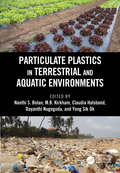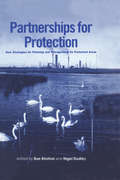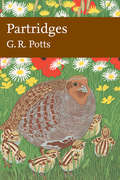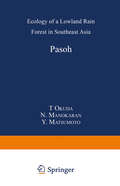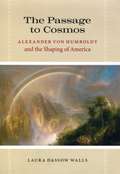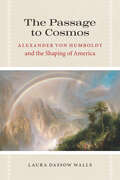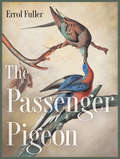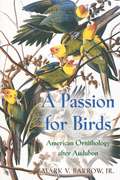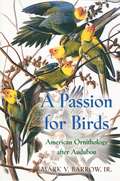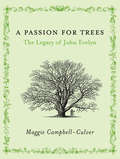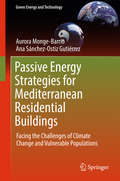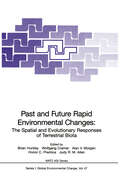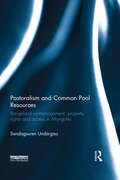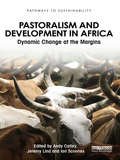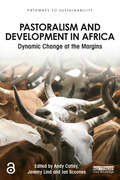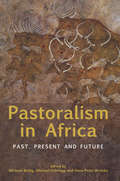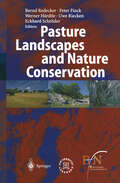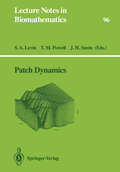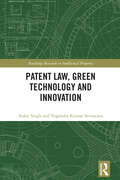- Table View
- List View
Particulate Plastics in Terrestrial and Aquatic Environments
by M. B. Kirkham Claudia Halsband Nanthi S. Bolan Dayanthi Nugegoda Yong-Sik OkThe manufacture of plastic as well as its indiscriminate disposal and destruction by incineration pollutes atmospheric, terrestrial, and aquatic ecosystems. Synthetic plastics do not break down; they accumulate in the environment as macro-, micro-, and nanoplastics. These particulate plastics are a major source of pollutants in soil and marine ecosystems. Particulate Plastics in Terrestrial and Aquatic Environments provides a fundamental understanding of the sources of these plastics and the threats they pose to the environment. The book demonstrates the ecotoxicity of particulate plastics using case studies and offers management practices to mitigate particulate plastic contamination in the environment. Features · Describes physical and chemical properties of particulate plastics in terrestrial and aquatic ecosystems · Presents information on characteristics of particulate plastics as impacted by weathering processes · Provides numerous approaches for managing particulate plastic contamination · Identifies sources of particulate plastics in the environment; distribution and characteristics of particulate plastics; and management strategies of particulate plastics Written by a global team of scientists, this book is for researchers in the fields of environmental safety and waste management or individuals interested in the impact of particulate plastics on environmental health.
Particulate Plastics in Terrestrial and Aquatic Environments
by Nanthi S. Bolan, M.B. Kirkham, Claudia Halsband, Dayanthi Nugegoda, Yong Sik OkThe manufacture of plastic as well as its indiscriminate disposal and destruction by incineration pollutes atmospheric, terrestrial, and aquatic ecosystems. Synthetic plastics do not break down; they accumulate in the environment as macro-, micro-, and nanoplastics. These particulate plastics are a major source of pollutants in soil and marine ecosystems. Particulate Plastics in Terrestrial and Aquatic Environments provides a fundamental understanding of the sources of these plastics and the threats they pose to the environment. The book demonstrates the ecotoxicity of particulate plastics using case studies and offers management practices to mitigate particulate plastic contamination in the environment. Features · Describes physical and chemical properties of particulate plastics in terrestrial and aquatic ecosystems · Presents information on characteristics of particulate plastics as impacted by weathering processes · Provides numerous approaches for managing particulate plastic contamination · Identifies sources of particulate plastics in the environment; distribution and characteristics of particulate plastics; and management strategies of particulate plastics Written by a global team of scientists, this book is for researchers in the fields of environmental safety and waste management or individuals interested in the impact of particulate plastics on environmental health.
Partnerships for Protection: New Strategies for Planning and Management for Protected Areas
by Sue Stolton Nigel DudleyTaking into consideration the fact that many ecosystems are under-represented in protected areas of land and water and traditional management methods have often been ineffective, this volume describes how improvements can be made. Specifically, it explores ways of ensuring that all major ecosystems are safeguarded, and innovative approaches to conservation involving individuals, communities, companies and governments. The essence of the approach taken in the text is to build partnerships with those who have a stake in the care of land and water resources.
Partnerships for Protection: New Strategies for Planning and Management for Protected Areas
by Sue Stolton Nigel Dudley Biksham Gujja Bill Jackson Jean-Paul Jeanrenaud Gonzalo Oviedo Pedro Rosabal Adrian Phillips Sue WellsTaking into consideration the fact that many ecosystems are under-represented in protected areas of land and water and traditional management methods have often been ineffective, this volume describes how improvements can be made. Specifically, it explores ways of ensuring that all major ecosystems are safeguarded, and innovative approaches to conservation involving individuals, communities, companies and governments. The essence of the approach taken in the text is to build partnerships with those who have a stake in the care of land and water resources.
Partridges: Countryside Barometer (Collins New Naturalist Library #121)
by G R PottsGlobally, there are at least 45 species of game bird that have the word partridge in their name, but in this book G. R. Potts devotes himself to the Grey, Red-legged and Chukar Partridges, with particular emphasis on the Grey Partridge due to its well-known decline in Britain.
Pasoh: Ecology of a Lowland Rain Forest in Southeast Asia
by T. Okuda N. Manokaran Y. Matsumoto K. Niiyama S. C. Thomas P. S. AshtonThe Pasoh Forest Reserve (pasoh FR) has been a leading center for international field research in the Asian tropical forest since the 1970s, when a joint research project was carried out by Japanese, British and Malaysian research teams with the cooperation of the University of Malaya (UM) and the Forest Research Institute (FRI, now the Forest Research Institute Malaysia, FRIM) under the International Biological Program (IBP). The main objective of the project was to provide basic information on the primary productivity ofthe tropical rain forest, which was thought to be the most productive of the world's ecosystems. After the IBP project, a collaborative program between the University of Malaya and the University of Aberdeen, Scotland, UK, for post-graduate training was carried out at Pasoh. Reproductive biology of so me dipterocarp trees featured in many of the findings arrived at through the program, contributing greatly to progress in the population genetics of rain forest trees. Since those research pro grams, apart of the Pasoh forest and its field research station have been managed by FRIM. In 1984, FRIM started a long-term ecological research program in Pasoh FR with the Smithsonian Tropical Research Institute (STRI) and Harvard University, establishing a 50-ha plot and enumerating and mapping all trees 1 cm or more in diameter at breast height. A recensus has been conducted every 5 years.
The Passage to Cosmos: Alexander von Humboldt and the Shaping of America
by Laura Dassow WallsExplorer, scientist, writer, and humanist, Alexander von Humboldt was the most famous intellectual of the age that began with Napoleon and ended with Darwin. With Cosmos, the book that crowned his career, Humboldt offered to the world his vision of humans and nature as integrated halves of a single whole. In it, Humboldt espoused the idea that, while the universe of nature exists apart from human purpose, its beauty and order, the very idea of the whole it composes, are human achievements: cosmos comes into being in the dance of world and mind, subject and object, science and poetry. Humboldt’s science laid the foundations for ecology and inspired the theories of his most important scientific disciple, Charles Darwin. In the United States, his ideas shaped the work of Emerson, Thoreau, Poe, and Whitman. They helped spark the American environmental movement through followers like John Muir and George Perkins Marsh. And they even bolstered efforts to free the slaves and honor the rights of Indians. Laura Dassow Walls here traces Humboldt’s ideas for Cosmos to his 1799 journey to the Americas, where he first experienced the diversity of nature and of the world’s peoples—and envisioned a new cosmopolitanism that would link ideas, disciplines, and nations into a global web of knowledge and cultures. In reclaiming Humboldt’s transcultural and transdisciplinary project, Walls situates America in a lively and contested field of ideas, actions, and interests, and reaches beyond to a new worldview that integrates the natural and social sciences, the arts, and the humanities. To the end of his life, Humboldt called himself “half an American,” but ironically his legacy has largely faded in the United States. The Passage to Cosmos will reintroduce this seminal thinker to a new audience and return America to its rightful place in the story of his life, work, and enduring legacy.
The Passage to Cosmos: Alexander von Humboldt and the Shaping of America
by Laura Dassow WallsExplorer, scientist, writer, and humanist, Alexander von Humboldt was the most famous intellectual of the age that began with Napoleon and ended with Darwin. With Cosmos, the book that crowned his career, Humboldt offered to the world his vision of humans and nature as integrated halves of a single whole. In it, Humboldt espoused the idea that, while the universe of nature exists apart from human purpose, its beauty and order, the very idea of the whole it composes, are human achievements: cosmos comes into being in the dance of world and mind, subject and object, science and poetry. Humboldt’s science laid the foundations for ecology and inspired the theories of his most important scientific disciple, Charles Darwin. In the United States, his ideas shaped the work of Emerson, Thoreau, Poe, and Whitman. They helped spark the American environmental movement through followers like John Muir and George Perkins Marsh. And they even bolstered efforts to free the slaves and honor the rights of Indians. Laura Dassow Walls here traces Humboldt’s ideas for Cosmos to his 1799 journey to the Americas, where he first experienced the diversity of nature and of the world’s peoples—and envisioned a new cosmopolitanism that would link ideas, disciplines, and nations into a global web of knowledge and cultures. In reclaiming Humboldt’s transcultural and transdisciplinary project, Walls situates America in a lively and contested field of ideas, actions, and interests, and reaches beyond to a new worldview that integrates the natural and social sciences, the arts, and the humanities. To the end of his life, Humboldt called himself “half an American,” but ironically his legacy has largely faded in the United States. The Passage to Cosmos will reintroduce this seminal thinker to a new audience and return America to its rightful place in the story of his life, work, and enduring legacy.
The Passage to Cosmos: Alexander von Humboldt and the Shaping of America
by Laura Dassow WallsExplorer, scientist, writer, and humanist, Alexander von Humboldt was the most famous intellectual of the age that began with Napoleon and ended with Darwin. With Cosmos, the book that crowned his career, Humboldt offered to the world his vision of humans and nature as integrated halves of a single whole. In it, Humboldt espoused the idea that, while the universe of nature exists apart from human purpose, its beauty and order, the very idea of the whole it composes, are human achievements: cosmos comes into being in the dance of world and mind, subject and object, science and poetry. Humboldt’s science laid the foundations for ecology and inspired the theories of his most important scientific disciple, Charles Darwin. In the United States, his ideas shaped the work of Emerson, Thoreau, Poe, and Whitman. They helped spark the American environmental movement through followers like John Muir and George Perkins Marsh. And they even bolstered efforts to free the slaves and honor the rights of Indians. Laura Dassow Walls here traces Humboldt’s ideas for Cosmos to his 1799 journey to the Americas, where he first experienced the diversity of nature and of the world’s peoples—and envisioned a new cosmopolitanism that would link ideas, disciplines, and nations into a global web of knowledge and cultures. In reclaiming Humboldt’s transcultural and transdisciplinary project, Walls situates America in a lively and contested field of ideas, actions, and interests, and reaches beyond to a new worldview that integrates the natural and social sciences, the arts, and the humanities. To the end of his life, Humboldt called himself “half an American,” but ironically his legacy has largely faded in the United States. The Passage to Cosmos will reintroduce this seminal thinker to a new audience and return America to its rightful place in the story of his life, work, and enduring legacy.
The Passage to Cosmos: Alexander von Humboldt and the Shaping of America
by Laura Dassow WallsExplorer, scientist, writer, and humanist, Alexander von Humboldt was the most famous intellectual of the age that began with Napoleon and ended with Darwin. With Cosmos, the book that crowned his career, Humboldt offered to the world his vision of humans and nature as integrated halves of a single whole. In it, Humboldt espoused the idea that, while the universe of nature exists apart from human purpose, its beauty and order, the very idea of the whole it composes, are human achievements: cosmos comes into being in the dance of world and mind, subject and object, science and poetry. Humboldt’s science laid the foundations for ecology and inspired the theories of his most important scientific disciple, Charles Darwin. In the United States, his ideas shaped the work of Emerson, Thoreau, Poe, and Whitman. They helped spark the American environmental movement through followers like John Muir and George Perkins Marsh. And they even bolstered efforts to free the slaves and honor the rights of Indians. Laura Dassow Walls here traces Humboldt’s ideas for Cosmos to his 1799 journey to the Americas, where he first experienced the diversity of nature and of the world’s peoples—and envisioned a new cosmopolitanism that would link ideas, disciplines, and nations into a global web of knowledge and cultures. In reclaiming Humboldt’s transcultural and transdisciplinary project, Walls situates America in a lively and contested field of ideas, actions, and interests, and reaches beyond to a new worldview that integrates the natural and social sciences, the arts, and the humanities. To the end of his life, Humboldt called himself “half an American,” but ironically his legacy has largely faded in the United States. The Passage to Cosmos will reintroduce this seminal thinker to a new audience and return America to its rightful place in the story of his life, work, and enduring legacy.
The Passenger: A Novel
by F. R. TallisNot all those on board are invited . . .1941. A German submarine, U-330, patrols the stormy inhospitable waters of the North Atlantic. It is commanded by Siegfried Lorenz, a maverick naval officer who does not believe in the war he is bound by duty and honour to fight in. U-330 receives a triple-encoded message with instructions to collect two prisoners from a vessel located off the Icelandic coast and transport them to the base at Brest, and British submarine commander, Sutherland, and an Norwegian academic, Professor Bjørnar Grimstad, are taken on board. Contact between the prisoners and Lorenz has been forbidden, and it transpires that this special mission has been ordered by an unknown source, high up in the SS. It is rumoured that Grimstad is working on a secret weapon that could change the course of the war . . . Then, Sutherland goes rogue, and a series of shocking, brutal events occurs. In the aftermath, disturbing things start happening on the boat. It seems that a lethal, supernatural force is stalking the crew, wrestling with Lorenz for control. A thousand feet under the dark, icy waves, it doesn't matter how loud you scream . . .
The Passenger Pigeon
by Errol FullerAt the start of the nineteenth century, Passenger Pigeons were perhaps the most abundant birds on the planet, numbering literally in the billions. The flocks were so large and so dense that they blackened the skies, even blotting out the sun for days at a stretch. Yet by the end of the century, the most common bird in North America had vanished from the wild. In 1914, the last known representative of her species, Martha, died in a cage at the Cincinnati Zoo. This stunningly illustrated book tells the astonishing story of North America's Passenger Pigeon, a bird species that—like the Tyrannosaur, the Mammoth, and the Dodo—has become one of the great icons of extinction. Errol Fuller describes how these fast, agile, and handsomely plumaged birds were immortalized by the ornithologist and painter John James Audubon, and captured the imagination of writers such as James Fenimore Cooper, Henry David Thoreau, and Mark Twain. He shows how widespread deforestation, the demand for cheap and plentiful pigeon meat, and the indiscriminate killing of Passenger Pigeons for sport led to their catastrophic decline. Fuller provides an evocative memorial to a bird species that was once so important to the ecology of North America, and reminds us of just how fragile the natural world can be. Published in the centennial year of Martha’s death, The Passenger Pigeon features rare archival images as well as haunting photos of live birds.
A Passion for Birds: American Ornithology after Audubon (PDF)
by Mark BarrowIn the decades following the Civil War--as industrialization, urbanization, and economic expansion increasingly reshaped the landscape--many Americans began seeking adventure and aesthetic gratification through avian pursuits. By the turn of the century, hundreds of thousands of middle-and upper-class devotees were rushing to join Audubon societies, purchase field guides, and keep records of the species they encountered in the wild. Mark Barrow vividly reconstructs this story not only through the experiences of birdwatchers, collectors, conservationists, and taxidermists, but also through those of a relatively new breed of bird enthusiast: the technically oriented ornithologist. In exploring how ornithologists struggled to forge a discipline and profession amidst an explosion of popular interest in natural history, A Passion for Birds provides the first book-length history of American ornithology from the death of John James Audubon to the Second World War. Barrow shows how efforts to form a scientific community distinct from popular birders met with only partial success. The founding of the American Ornithologists' Union in 1883 and the subsequent expansion of formal educational and employment opportunities in ornithology marked important milestones in this campaign. Yet by the middle of the twentieth century, when ornithology had finally achieved the status of a modern profession, its practitioners remained dependent on the services of birdwatchers and other amateur enthusiasts. Environmental issues also loom large in Barrow's account as he traces areas of both cooperation and conflict between ornithologists and wildlife conservationists. Recounting a colorful story based on the interactions among a wide variety of bird-lovers, this book will interest historians of science, environmental historians, ornithologists, birdwatchers, and anyone curious about the historical roots of today's birding boom.
A Passion for Birds: American Ornithology after Audubon
by Mark BarrowIn the decades following the Civil War--as industrialization, urbanization, and economic expansion increasingly reshaped the landscape--many Americans began seeking adventure and aesthetic gratification through avian pursuits. By the turn of the century, hundreds of thousands of middle-and upper-class devotees were rushing to join Audubon societies, purchase field guides, and keep records of the species they encountered in the wild. Mark Barrow vividly reconstructs this story not only through the experiences of birdwatchers, collectors, conservationists, and taxidermists, but also through those of a relatively new breed of bird enthusiast: the technically oriented ornithologist. In exploring how ornithologists struggled to forge a discipline and profession amidst an explosion of popular interest in natural history, A Passion for Birds provides the first book-length history of American ornithology from the death of John James Audubon to the Second World War. Barrow shows how efforts to form a scientific community distinct from popular birders met with only partial success. The founding of the American Ornithologists' Union in 1883 and the subsequent expansion of formal educational and employment opportunities in ornithology marked important milestones in this campaign. Yet by the middle of the twentieth century, when ornithology had finally achieved the status of a modern profession, its practitioners remained dependent on the services of birdwatchers and other amateur enthusiasts. Environmental issues also loom large in Barrow's account as he traces areas of both cooperation and conflict between ornithologists and wildlife conservationists. Recounting a colorful story based on the interactions among a wide variety of bird-lovers, this book will interest historians of science, environmental historians, ornithologists, birdwatchers, and anyone curious about the historical roots of today's birding boom.
A Passion For Trees: The Legacy Of John Evelyn
by Maggie Campbell-CulverGiven the extent of his influence on 17th-century life, and his lasting impact on the British landscape it is remarkable that no book has been written before about John Evelyn. He was a longstanding friend of Samuel Pepys (who wrote of him, ' A most excellent person he is, and must be allowed a little for conceitedness; but he may well be so, being a man so much above others.'), a founder-member of the Royal Society and a prolific writer and diarist. He was an early advocate of the garden city but his most important work was Sylva: a Discourse of Forest Trees. Sylva was presented to the Royal Society to promote the planting of timber trees 'for the supply of the Navy, the employment and advantage of the poor as well as the ornamenting of the nation.' He was responsible for the first great raft of tree-planting and for a great influx of tree introductions to Britain.Maggie Campbell-Culver's book, like Sylva, has at its core a section detailing the characteristics, history and uses of 33 trees incorporating the advice Evelyn gave and demonstrating its relevance still in the 20th-century. Not only was Evelyn probably the first horticultural writer to show an appreciation of the aesthetic benefits of trees in our landscape, he is shown to be a founder-father of the modern conservation movement.
Passive Energy Strategies for Mediterranean Residential Buildings: Facing the Challenges of Climate Change and Vulnerable Populations (Green Energy and Technology)
by Aurora Monge-Barrio Ana Sánchez-Ostiz GutiérrezThis book presents an approach to energy-efficient building design, which takes into account the most important challenges in climate change mitigation and adaptation in Southern Europe. It outlines a specific approach related to residential buildings and their intergenerational and vulnerable occupants, such as ageing population and users in fuel poverty. It also focuses on the use of passive energy measures throughout the year, and on pursuing a realistic and affordable approach to the efficient rehabilitation of resilient residential buildings.In addition, the book presents case studies that include surveys, monitoring, and simulation of residential buildings in Spain and other Southern European representative locations, in order to go further on the study of this challenging topic.
Past and Future Rapid Environmental Changes: The Spatial and Evolutionary Responses of Terrestrial Biota (Nato ASI Subseries I: #47)
by Brian Huntley Wolfgang Cramer Alan V. Morgan Honor C. Prentice Judy R. M. AllenNumerous experts including ecologists, geneticists, paleontologists and climatologists, investigate the response of terrestrial organisms to changes in their environment. The volume comprises an introductory and a final chapter by the editors as well as another 35 contributions. These are divided into six sections: 1. past environmental changes - the late-Quaternary; 2. spatial responses to past changes; 3. mechanisms enabling spatial responses; 4. evolutionary responses to past changes; 5. mechanisms enabling evolutionary responses; 6. predicted future environmental changes and simulated responses. The overwhelming and unanimous conclusion of all contributors is that forecasted global environmental changes pose a severe threat to the integrity of ecosystems worldwide and to the survival of at least some species.
Pastoralism and Common Pool Resources: Rangeland co-management, property rights and access in Mongolia
by Sandagsuren UndargaaThe grazing of animals on common land and associated property rights were the original basis of the concept of "the tragedy of the commons". Drawing on the classic work of Elinor Ostrom and the readings of political ecology, this book questions the application of exclusive property rights to mobile pastoralism and rangeland resource governance. It argues that this approach inadequately represents property relations in the context of Mongolian pastoralism. The author presents an in-depth exploration and analysis of mobile pastoral production and resource management in Mongolia. The country is widely considered to be a prime example of successful and resilient common pool resource management, but now faces a dilemma as policy advocates attempt to adjust historical pastoralism to a modern property regime framework. The book strengthens understanding of the complex and multilateral considerations involved in natural resource governance and management in a mobile pastoralist context. It considers the implications for common pool resource management and pastoral societies in Africa, Russia and China and includes recommendations for formulating national policy.
Pastoralism and Common Pool Resources: Rangeland co-management, property rights and access in Mongolia
by Sandagsuren UndargaaThe grazing of animals on common land and associated property rights were the original basis of the concept of "the tragedy of the commons". Drawing on the classic work of Elinor Ostrom and the readings of political ecology, this book questions the application of exclusive property rights to mobile pastoralism and rangeland resource governance. It argues that this approach inadequately represents property relations in the context of Mongolian pastoralism. The author presents an in-depth exploration and analysis of mobile pastoral production and resource management in Mongolia. The country is widely considered to be a prime example of successful and resilient common pool resource management, but now faces a dilemma as policy advocates attempt to adjust historical pastoralism to a modern property regime framework. The book strengthens understanding of the complex and multilateral considerations involved in natural resource governance and management in a mobile pastoralist context. It considers the implications for common pool resource management and pastoral societies in Africa, Russia and China and includes recommendations for formulating national policy.
Pastoralism and Development in Africa: Dynamic Change at the Margins (Pathways to Sustainability)
by Andy Catley Jeremy Lind Ian Scoones Jeremy LindeckOnce again, the Horn of Africa has been in the headlines. And once again the news has been bad: drought, famine, conflict, hunger, suffering and death. The finger of blame has been pointed in numerous directions: to the changing climate, to environmental degradation, to overpopulation, to geopolitics and conflict, to aid agency failures, and more. But it is not all disaster and catastrophe. Many successful development efforts at ‘the margins’ often remain hidden, informal, sometimes illegal; and rarely in line with standard development prescriptions. If we shift our gaze from the capital cities to the regional centres and their hinterlands, then a very different perspective emerges. These are the places where pastoralists live. They have for centuries struggled with drought, conflict and famine. They are resourceful, entrepreneurial and innovative peoples. Yet they have been ignored and marginalised by the states that control their territory and the development agencies who are supposed to help them. This book argues that, while we should not ignore the profound difficulties of creating secure livelihoods in the Greater Horn of Africa, there is much to be learned from development successes, large and small. This book will be of great interest to students and scholars with an interest in development studies and human geography, with a particular emphasis on Africa. It will also appeal to development policy-makers and practitioners.
Pastoralism and Development in Africa: Dynamic Change at the Margins (Pathways to Sustainability)
by Author UnknownOnce again, the Horn of Africa has been in the headlines. And once again the news has been bad: drought, famine, conflict, hunger, suffering and death. The finger of blame has been pointed in numerous directions: to the changing climate, to environmental degradation, to overpopulation, to geopolitics and conflict, to aid agency failures, and more. But it is not all disaster and catastrophe. Many successful development efforts at ‘the margins’ often remain hidden, informal, sometimes illegal; and rarely in line with standard development prescriptions. If we shift our gaze from the capital cities to the regional centres and their hinterlands, then a very different perspective emerges. These are the places where pastoralists live. They have for centuries struggled with drought, conflict and famine. They are resourceful, entrepreneurial and innovative peoples. Yet they have been ignored and marginalised by the states that control their territory and the development agencies who are supposed to help them. This book argues that, while we should not ignore the profound difficulties of creating secure livelihoods in the Greater Horn of Africa, there is much to be learned from development successes, large and small. This book will be of great interest to students and scholars with an interest in development studies and human geography, with a particular emphasis on Africa. It will also appeal to development policy-makers and practitioners.
Pastoralism in Africa: Past, Present and Future
by Michael Bollig Michael Schnegg Hans-Peter WotzkaPastoralism has shaped livelihoods and landscapes on the African continent for millennia. Mobile livestock husbandry has generally been portrayed as an economic strategy that successfully met the challenges of low biomass productivity and environmental variability in arid and semi-arid environments. This volume focuses on the emergence, diversity, and inherent dynamics of pastoralism in Africa based on research during a twelve-year period on the southwest and northeast regions. Unraveling the complex prehistory, history, and contemporary political ecology of African pastoralism, results in insight into the ingenuity and flexibility of historical and contemporary herders.
Pasture Landscapes and Nature Conservation
by Bernd Redecker Eckhard Schröder Werner Härdtle Peter Finck Uwe RieckenOne of the main problems and aims of nature conservation in Europe is to protect semi-open landscapes. The development during the past decades is characterized by an ongoing intensivation of land use on the one hand, and an increasing number of former meadows and pastures lying fallow caused by changing economic conditions on the other hand. In several countries the estabishment of larger "pasture landscapes" with a mixed character of open grassland combined with shrubs and forests has been recognized as one solution to this problem. The book gives an overview of the European projects concerning to this topic - nature conservation policy and strategies, scientific results and practical experiences creating large scale grazing systems.
Patch Dynamics (Lecture Notes in Biomathematics #96)
by Simon A. Levin Thomas M. Powell John H. SteeleFrom the preface by Joel E. Cohen: "A century from now humanity will live in a managed - or mismanaged - global garden. We are debating the need to preserve tropical forests. Farming of the sea is providing an increasing part of our fish supply. We are beginning to control atmospheric emissions. In 100 years, we shall use novel farming practices and genetic engineering of bacteria to manipulate the methane production of rice fields. The continental shelf will be providing food, energy, possibly even living space. To make such intensive management possible will require massive improvements in data collection and analysis, and especially in our concepts. A century hence we will live on a wired earth: the oceans and the crust of the earth will receive the same comprehensive monitoring now devoted to weather. As the peoples of currently developing countries increase their levels of wealth, the need for global management will become irresistible as impatience with the accidents of nature and intolerance of mismanagement of the environment - especially of living resources - grow. Our control of physical perturbations and chemical inputs to the environment will be judged by the consequences to living organisms and biological communities. How can we obtain the factual and theoretical foundation needed to move from our present, fragmented knowledge and limited abilities to a managed, global garden?" This problem was addressed in the lectures and workshops of a summer school on patch dynamics at Cornell University. The school emphasized the analysis and interpretation of spatial patterns in terrestrial and marine environments. This book contains the course material of this school, combining general reviews with specific applications.
Patent Law, Green Technology and Innovation (Routledge Research in Intellectual Property)
by Ankit Singh Yogendra Kumar SrivastavaIn the era of modern industrial regimes, the role of technology in tackling climate change is pivotal. International goals of climate change mitigation and sustainable development cannot be achieved without the contribution of new technologies. At the same time, the importance of patent protection and an efficient patent system that facilitates technology transfer among international frontiers cannot be overlooked. Many patented technologies are either not accessible for further dissemination or do not hold much technical value. Therefore, advanced systems of collaborative innovation have been developed, especially in the sector of green technology and green innovation. The environmental concerns of the global community cannot be tackled by a single company, person, sector or country. Innovation partnerships and collaborative research will play a vital role in combating global climate concerns and in determining the diffusion of green technologies for maximum impact. This book argues that policy-makers should encourage partnerships in technology rather than focusing on gaining investment and access to green technology to encourage global technological giants to transfer their technology and knowledge to local entities. It analyses the relationship between patent protection, green innovation and diffusion of green technology against the backdrop of climate change and severe climate crisis. Taking an interdisciplinary approach to align patent law and green technology with the Sustainable Development Goals, it examines the effects of patent protection, technology transfer and compulsory licensing on the diffusion of green technologies it offering a systematic analysis of the relationship between patent protection, green innovation and diffusion of green technology from a global perspective.
